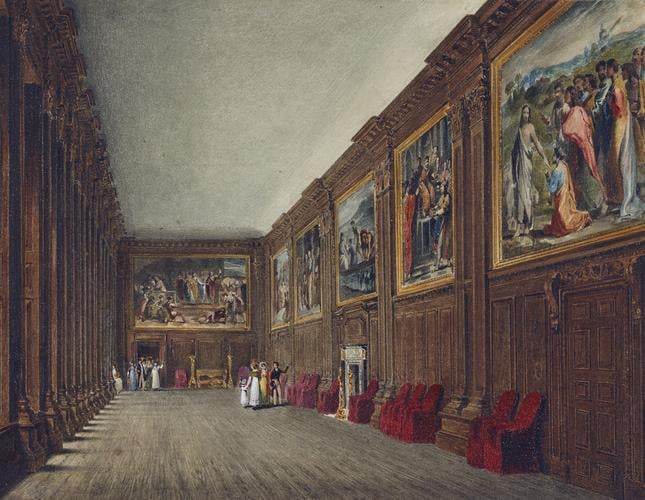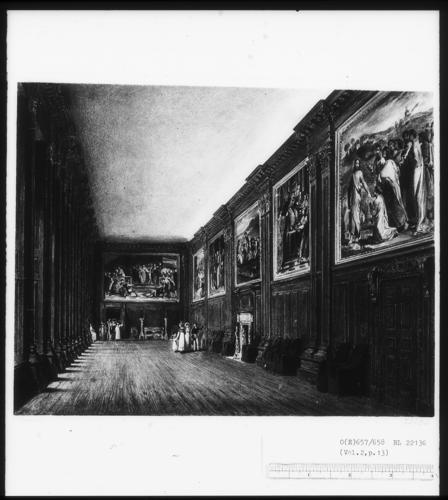Hampton Court Palace: The Cartoon Gallery, 1818 1818
Watercolour with touches of bodycolour over pencil | 19.9 x 25.7 cm (sheet of paper) | RCIN 922136
-
William III's new State Apartments at Hampton Court Palace were begun in 1689. Constructed to the designs of Christopher Wren at the south-east corner of the old Tudor palace around two sides of a new courtyard, the King's rooms faced south over the Privy Garden and the Queen's faced east over the Fountain Garden. The King's or Cartoon Gallery lay on the inner north-facing side of the King's range, parallel to the suite of interconnecting rooms forming the main axis of the King's Apartment. Work on fitting out the Gallery was under way in 1691 but this and all other work at Hampton Court came to an abrupt halt with the sudden death of Queen Mary II in 1694. Nothing further was done until 1698 when John Norris, Joiner to the Privy Chamber, was employed to install the celebrated Raphael Cartoons in the elevated positions specifically designed to fit them. By the end of the following year, William Talman having supplanted Wren, the rest of the King's State Apartment was finished, although decoration and furnishing continued over the next two years. For this brief period until his death in 1702, William III used the Cartoon Gallery for meetings of the Privy Council. There were no significant changes to the Gallery before the accession of George III in 1760. Thereafter Hampton Court Palace ceased to be used by the royal family and the arrangement of the State Apartments became more haphazard as furniture and pictures were taken to other palaces and the State Apartments lost their significance.
The pier table and torchères shown in Stephanoff's view at the far end of the Gallery are likely to have been made originally for the Prince of Wales's Apartment. The Raphael Cartoons are in situ, although they had moved twice since their original installation in 1698: first to Queen Charlotte's Saloon in Buckingham House, then to George III's apartments at Windsor Castle. At the King's suggestion they were returned to Hampton Court in 1804. In the 1820s John Nash thought of moving them again to Buckingham Palace to hang in George III's Octagon Library, which he proposed to convert into a private chapel, but they remained at Hampton Court until 1865 when they were deposited by Queen Victoria on loan to the new South Kensington Museum - now the Victoria and Albert Museum - where they remain. Early in the twentieth century, a set of eighteenth-century Brussels tapestries woven with the Acts of the Apostles (based on the Raphael Cartoons) was placed in the Gallery; and after the fire of 1986 the opportunity was taken to replace the tapestries with late seventeenth-century painted copies of the cartoons lent from the Ashmolean Museum, Oxford.
Catalogue entry from Royal Treasures, A Golden Jubilee Celebration, London 2002Provenance
Probably acquired by George IV
-
Creator(s)
Acquirer(s)
-
Medium and techniques
Watercolour with touches of bodycolour over pencil
Measurements
19.9 x 25.7 cm (sheet of paper)
Object type(s)
Other number(s)
RL 22136Alternative title(s)
The Cartoon Gallery, Hampton Court










